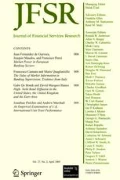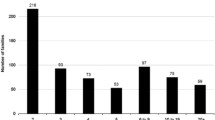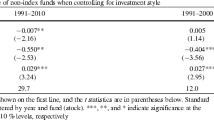Abstract
In this paper we investigate the tournament induced risk-shifting behavior of Australian “multi-sector growth funds”. We apply a regression-based methodology and examine tournaments based on the calendar year and the financial year. In our core analysis we find evidence in favor of Taylor’s (J Econ Behav Organ 1455:1–11, 2003) risk shifting tournament hypothesis for financial year-end tournaments. Apart from the standard tournament hypothesis we also report a range of findings regarding stability; fund age; and fund size. Support for the Taylor hypothesis generally continues across these variations as well.
Similar content being viewed by others
Notes
BHS’s results indicated that losers did indeed appear to gamble, a result confirmed by Koski and Pontiff (1999) looking at US funds and Garcia and Begona (2000) looking at Spanish mutual funds. Kempf and Ruenzi (2003) extend the tournament model to mutual fund families, finding support for the BHS hypothesis in large fund families but finding the opposite result, that is, that winners increase risk the most, in small fund families.
Busse (2001) found no evidence of a tournament effect when examining daily data for US equity funds. He argued that autocorrelation in daily fund returns could bias monthly volatility estimates, leading to the spurious appearance of a tournament effect, and suggested intra-period risk changes were due to changes in the volatility of stock market common risk factors. However, Goriaev et al. (2005) find that tests of the tournament hypothesis based on monthly data are more robust to autocorrelation effects than tests based on daily data. Nevertheless, they also find that cross-correlation in fund returns may lead to spurious tournament effects.
As a final complication, in a number of cases, funds adopt an October–September reporting year. The 30 September financial reporting year is a legacy of the reporting year adopted early in the 20th century by a number of banks and insurance offices of British origin. In recent times there has been a move to discard this in favor of a standard financial or calendar year reporting period. Given the relatively low incidence of this reporting period, it is not analyzed in this paper.
At the time of the introduction of the mandatory superannuation contributions the rate was between 3% and 5% of the salary depending on the payroll size. It increased to 9% in 2003.
Source: Reserve Bank of Australia Bulletin Statistical Tables, Table B18 Managed Funds, June 2005.
APRA is the prudential regulator of the Australian financial services industry. It oversees banks, credit unions, building societies, general insurance and reinsurance companies, life insurance, friendly societies, and most members of the superannuation industry.
The Superannuation Industry (Supervision) Act (SIS) Act requires audited annual reports to members. AAS25 Australian Accounting Standard provides guidelines for disclosures.
A number of studies such as Grinblatt and Titman (1989), Brown et al. (1992), Carpenter and Lynch (1999) and Carhart et al. (2002) document the economic significance of survivorship bias in studies of equity mutual fund performance, particularly in relation to the issue of persistence in performance. However, and as noted by Del Guercio and Tkac (2002), studies by Sirri and Tufano (1998), Chevalier and Ellison (1997) and Goetzmann and Peles (1997) find that survivorship bias does not affect inferences about the funds flow-performance relationship and, therefore, is not a major issue in studies involving annual tournaments.
To conform with US analysis, Eq. 1 is estimated using calendar year end data.
Our time series data are structured as an unbalanced pool and equations are estimated using OLS adjusted for heteroskedasticity. Initial estimations show low Durbin-Watson statistics indicating serial correlation. Therefore, the model is re-estimated incorporating an AR(1) term (but not reported). The central thrust of our findings are unaffected by this accommodation.
Both variables in the equation are asterisked to indicate that the standardization process has been applied, as discussed at the end of the preceding sub-section.
Variations of these basic tests are applied to all the models that follow.
Unfortunately we are unable to analyze the period prior to the introduction of the Superannuation guarantee levy. Our data starts mid 1989 and the levy was introduced in 1992 hence the tournament analysis is not practical over such a short time frame.
References
Axiss Australia (2005) Australia, a global financial services centre: benchmark report August 2005, Australian Government
Benson K, Tang G, Tutticci I (2008) The relevance of family characteristics to individual fund flows. Aust J Manage 32(2):419–443
Brown KC, Harlow WV, Starks LT (1996) Of tournaments and temptations: an analysis of managerial incentives in the mutual fund industry. J Finance 15:85–110
Brown SJ, Goetzmann W, Ibbotson RG, Ross SA (1992) Survivorship bias in performance studies. Rev Financ Stud 5:553–580
Busse JA (2001) Another look at mutual fund tournaments. J Financ Quant Anal 36:53–73
Capon N, Fitzsimons GJ, Prince RA (1996) An individual level analysis of the mutual fund investment decision. J Financ Serv Res 10:59–82
Carhart MM, Carpenter JN, Lynch AW, Musto DK (2002) Mutual fund survivorship. Rev Financ Stud 15:1439–1463
Carpenter JN, Lynch AW (1999) Survivorship bias and attrition effects in measures of performance persistence. J Financ Econ 54:337–374
Chevalier J, Ellison G (1997) Risk taking by mutual fund as a response to incentives. J Polit Econ 105:1167–1200
Del Guercio D, Tkac PA (2002) The determinants of the flow of funds of managed portfolios: Mutual funds vs. pension funds. J Financ Quant Anal 37:523–557
Drew ME, Stanford JD (2003) Principal and agent problems in superannuation funds. Aust Econ Rev 36:98–107
Frino A, Heaney R, Service D (2005) Do past performance and past cash flows explain current cash flows into retail superannuation funds in Australia. Aust J Manage 30:229–244
Garcia OM, Begona TO (2000) Managers’ incentives to mutual fund performance: an empirical investigation in the Spanish market. Working Paper (University of Cantabria. Spain)
Goetzmann WN, Peles N (1997) Cognitive dissonance and mutual fund investors. J Financ Res 20:145–158
Goriaev A, Nijman TE, Werker BJM (2005) Yet another look at mutual fund tournaments. J Empir Finance 12:127–137
Grinblatt M, Titman S (1989) Mutual fund performance: an analysis of quarterly portfolio holdings. J Business 62:393–416
Ipplito RA (1992) Consumer reaction to measures of poor quality funds from the mutual fund industry. J Law Econ 35:45–70
Kempf A, Ruenzi S (2003) Tournaments in mutual fund families. EFA 2003 Annual Conference Paper, University of Cologne Finance Discussion Paper No 2002-1
Koski JL, Pontiff J (1999) How are derivatives used? Evidence from the mutual fund industry. J Finance 54:791–810
Massa M (2003) How do family strategies affect fund performance? When performance-maximization is not the only game in town. J Financ Econ 67:249–304
Qui J (2003) Termination risk, multiple managers and mutual fund tournaments. European Finance Review 7:161–190
Sawicki J (2000) Investors’ response to the performance of professional fund managers: evidence from the Australian Wholesale Funds Market. Aust J Manage 25:47–66
Sawicki J (2001) Investor’s differential response to managed fund performance. J Financ Res 24:367–384
Sirri ER, Tufano P (1998) Costly search and mutual fund flows. J Finance 54:1589–1623
Taylor J (2003) Risk-taking behavior in mutual fund tournaments. J Econ Behav Organ 1455:1–11
Wilcox RT (2003) Bargain hunting or star gazing? Investors preferences for stock mutual funds. J Business 76:4
Acknowledgements
The authors are grateful to an anonymous referee for constructive suggestions. The Australian Research Council is acknowledged for financial support: DPP0773662.
Author information
Authors and Affiliations
Corresponding author
Rights and permissions
About this article
Cite this article
Hallahan, T., Faff, R.W. & Benson, K.L. Fortune Favours the Bold? Exploring Tournament Behavior among Australian Superannuation Funds. J Finan Serv Res 33, 205–220 (2008). https://doi.org/10.1007/s10693-008-0030-y
Received:
Revised:
Accepted:
Published:
Issue Date:
DOI: https://doi.org/10.1007/s10693-008-0030-y




